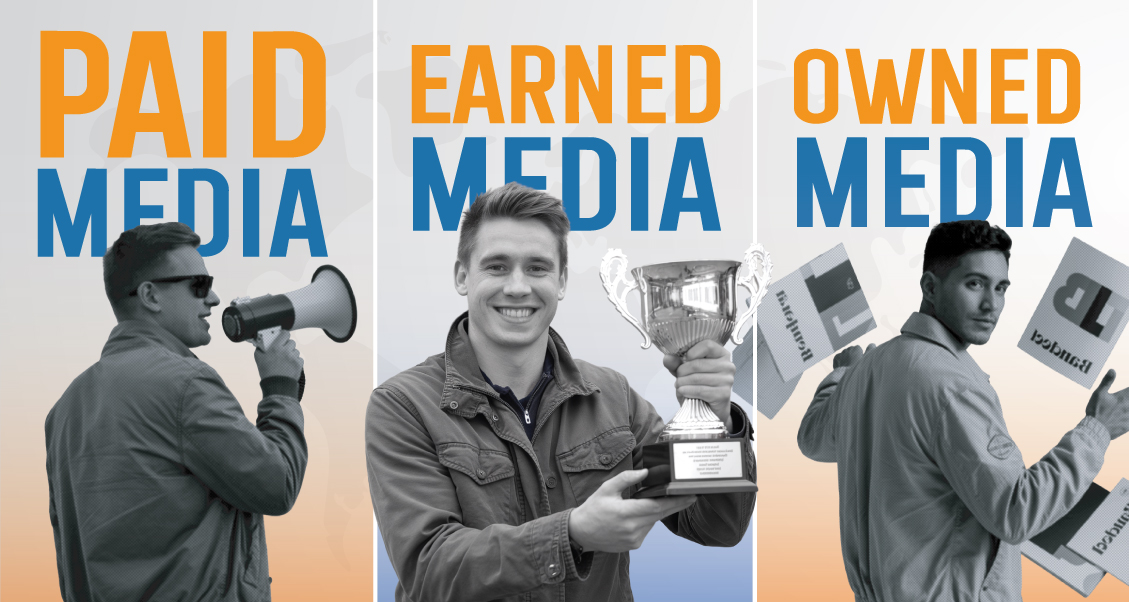Paid, Owned, and Earned Media: The Triad of Effective Digital Marketing

Paid, Owned, and Earned Media: The Triad of Effective Digital Marketing
Paid, Owned, and Earned Media: The Triad of Effective Digital Marketing
In the dynamic landscape of digital marketing, understanding and effectively utilizing Paid, Owned, and Earned Media is crucial for business success. These three media types form the backbone of comprehensive marketing strategies, each playing a distinct role in reaching and engaging target audiences. This blog delves into what each media type entails, their differences, and how to integrate them seamlessly to maximize your marketing efforts.
Understanding the Three Types of Media
Marketing communication today leverages various media channels to promote products and services. These channels are broadly categorized into Paid, Owned, and Earned Media, each serving a unique purpose in the marketing ecosystem. Achieving the ideal balance among these media types ensures comprehensive audience reach and effective engagement.
Why Balance Matters
- Comprehensive Insights: Each media type offers distinct insights into customer behavior and interactions.
- Enhanced Reach: Utilizing all three media types ensures your brand is visible across multiple platforms.
Increased Credibility: A balanced media strategy builds trust and credibility with your audience.

Paid Media
What is Paid Media?
Paid Media refers to any marketing effort that involves paying to display promotional content on external platforms. This includes both digital and traditional advertising channels.
Types of Paid Media
- Paid Search: Ads that appear in response to users actively searching for your products, services, or brand on search engines like Google.
- Display Advertising: Visual ads shown on websites, social media platforms, and other digital channels to attract potential customers who may not be actively searching for your offerings.
- Social Media Ads: Sponsored posts and advertisements on platforms like Facebook, Instagram, LinkedIn, and Twitter.
- Traditional Ads: Television commercials, print ads in magazines and newspapers, radio spots, and billboards.
Advantages of Paid Media
- Wide Reach: Ability to reach a large and diverse audience quickly.
- Advanced Targeting: Utilize demographic, geographic, and behavioral data to target specific segments.
- Performance Tracking: Easily track and measure the effectiveness of campaigns, allowing for real-time adjustments.
Effective Formats
- Video Ads: Highly engaging and effective, especially on platforms like YouTube, Instagram, and TikTok.
Mobile Advertising: Paid YouTube mobile ads, for instance, are 84% more likely to capture viewers’ attention compared to traditional TV ads.

Owned Media
What is Owned Media?
Owned Media encompasses all digital content that your company creates and controls. This includes any platform or content you own and can publish without additional costs.
Types of Owned Media
- Company Website: The central hub for your online presence, providing information about your products, services, and brand.
- Blogs: Regularly updated articles that offer valuable insights, industry news, and thought leadership.
- Social Media Channels: Organic posts on platforms like Facebook, Twitter, LinkedIn, and Instagram (excluding paid ads).
- Email Marketing: Newsletters and promotional emails sent directly to your subscriber list.
Advantages of Owned Media
- Cost-Effective: Lower costs compared to paid media as it primarily involves content creation and maintenance.
- Full Control: Complete authority over the content, messaging, and branding.
- Long-Term Value: Content can continue to attract and engage audiences over time, especially with effective SEO strategies.
Strategies for Owned Media
- Search Engine Optimization (SEO): Optimize website and blog content with relevant keywords to improve search engine rankings and increase organic traffic.
Content Control: Manage the placement, targeting, and storytelling to effectively engage your audience across all stages of the marketing funnel.

Earned Media
What is Earned Media?
Earned Media is the publicity gained through word of mouth, customer reviews, social media mentions, and media coverage that is not paid for or owned by the company. It is essentially the organic buzz surrounding your brand.
Types of Earned Media
- Customer Reviews: Feedback and ratings on platforms like Yelp, Google Reviews, and Trustpilot.
- Social Media Mentions: Shares, reposts, and mentions by users on platforms like Twitter, Instagram, and Facebook.
- Media Coverage: News articles, blog features, and press mentions that highlight your brand.
- Influencer Endorsements: Authentic recommendations from influencers who genuinely support your brand.
Advantages of Earned Media
- Increased Credibility: Consumers trust recommendations and reviews from peers more than traditional advertising.
- Expanded Reach: Organic sharing and mentions can significantly amplify your brand’s visibility.
- Cost Efficiency: Earned media can enhance your marketing efforts without the direct costs associated with paid media.
Considerations
- Time and Effort: Building earned media requires consistent quality and engagement to encourage organic sharing.
- Risk of Negative Messaging: Negative reviews or feedback can also spread, potentially harming your brand’s reputation.
Key Differences Between Paid, Owned, and Earned Media
Control
- Owned Media: Highest level of control over content and brand messaging.
- Paid Media: Controlled through budget allocation and strategic ad placements.
- Earned Media: Limited control; relies on organic consumer behavior and third-party content.
Cost
- Paid Media: Direct financial investment in advertising campaigns.
- Owned Media: Indirect costs related to content creation, maintenance, and resource allocation.
- Earned Media: Indirect costs such as expenses for influencer partnerships and managing public relations efforts.
Impact on the Marketing Funnel
- Awareness Stage:
- Paid Media: Boosts brand visibility and quickly attracts potential customers.
- Owned Media: Enhances brand discovery through organic search and engaging content.
- Consideration Stage:
- Earned Media: Influences customer evaluation through trusted reviews and recommendations.
- Decision Stage:
- Earned Media: Personal endorsements and reviews can drive purchasing decisions.
- Owned Media: Provides persuasive and informative content to facilitate conversions.
Integrating Paid, Owned, and Earned Media
A balanced media strategy leverages all three media types to create a cohesive and comprehensive marketing approach. This ensures that your brand remains visible and engages with customers across various touchpoints.
Practical Example: Restaurant Booking Process
- Owned Media:
- Google Maps: Customers search for nearby restaurants, discovering your business through your optimized Google My Business listing.
- Earned Media:
- Yelp Reviews: Positive reviews and ratings enhance credibility and attract new customers.
- Instagram Photos: User-generated content showcasing your dishes builds visual appeal and authenticity.
- Paid Media:
- Facebook Ads: Targeted advertisements promote special offers and events, driving traffic to your website or reservation system.
Enhancing Brand Recall and Engagement
By appearing across multiple platforms, your brand becomes more memorable. Consistent messaging and visual identity across paid, owned, and earned media reinforce your brand’s presence and encourage customer engagement.
Measuring and Optimizing Your Media Strategy
Performance Tracking
- Analytics Tools: Utilize tools like Google Analytics, social media insights, and marketing dashboards to monitor the performance of each media type.
- Key Metrics:
- Paid Media: Click-through rates (CTR), conversion rates, return on ad spend (ROAS).
- Owned Media: Website traffic, bounce rates, time on site, SEO rankings.
- Earned Media: Social shares, mentions, sentiment analysis, review ratings.
Optimization Strategies
- Data-Driven Decisions: Use performance data to refine and adjust your strategies for each media type.
- A/B Testing: Experiment with different content formats, messaging, and targeting to identify what resonates best with your audience.
- Continuous Improvement: Regularly update and enhance your content, ads, and engagement tactics based on feedback and performance insights.
Conclusion
In the realm of digital marketing, Paid, Owned, and Earned Media form a synergistic triad that drives business growth and brand success. By understanding the unique roles and advantages of each media type, and strategically integrating them into your marketing plan, you can achieve a balanced and effective approach that maximizes reach, builds trust, and fosters long-term customer relationships.
Final Takeaways
- Balance is Key: Utilize all three media types to create a comprehensive and resilient marketing strategy.
- Continuous Measurement: Regularly track and analyze performance to optimize your efforts.
- Adapt and Evolve: Stay agile and adapt to changing digital trends and consumer behaviors to maintain relevance and effectiveness.
By leveraging the strengths of paid, owned, and earned media, your business can navigate the complexities of digital marketing with confidence, ensuring sustained visibility and engagement in an ever-evolving marketplace.

Blog Admin:
Ravinder Bharti
CEO & Founder - Public Media Solution
About: Ravinder Bharti is the Founder and CEO of Public Media Solution,
a leading
marketing, PR, and branding company based in India.